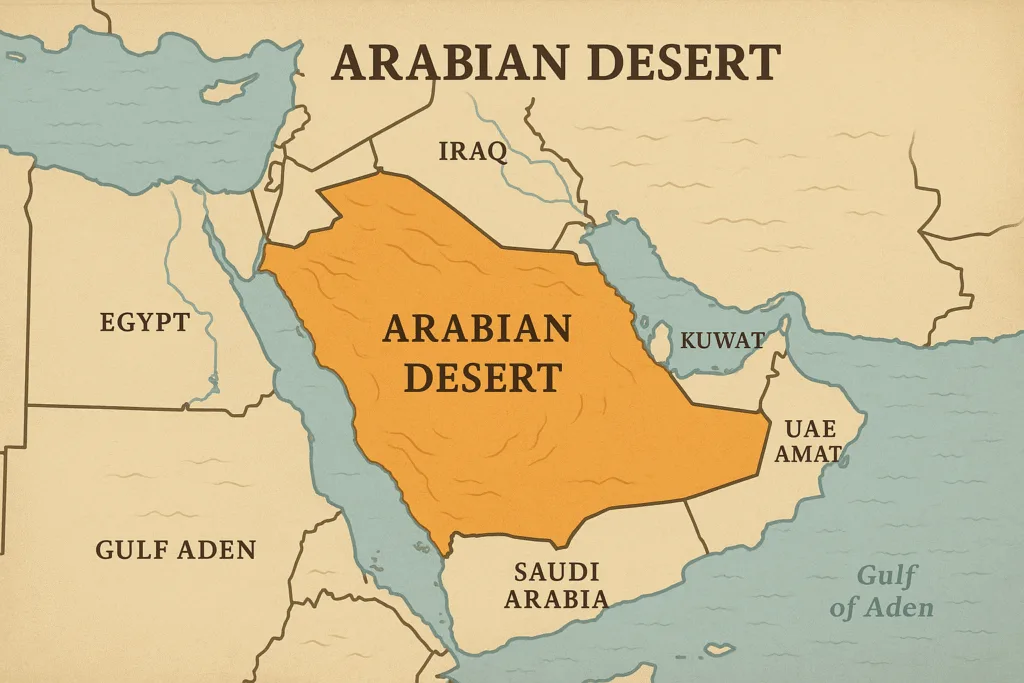Location & Continent
Continent: Asia
Country: China (Xinjiang Uyghur Autonomous Region)
Coordinates: 40°N, 91°E
Kumtag Desert – Map & Street View
Photos of the Kumtag Desert

Physical Features
Area: ~22,000 km² (a smaller but striking desert within the eastern Tarim Basin)
Length: ~400 km (east–west)
Width: ~60–200 km (north–south)
Elevation: Generally 780–1,200 m above sea level, with higher dune ridges along the northern margin
Climate & Precipitation
Temperature: Summers reach 45–50 °C; winters fall below −25 °C
Precipitation: Less than 30 mm per year, concentrated in brief summer storms; extreme aridity defines most of the landscape
Ecological Features
Ecozone: Palearctic (cold desert and arid steppe transition zone)
Biome: Temperate desert (sand sea with salt flats and dry riverbeds)
Ecoregions: Eastern Tarim Basin Desert, Lop Nur Basin fringe, Kumtag Sand Sea
Flora & Fauna
Flora: Sparse and drought-resistant vegetation such as saxaul (Haloxylon ammodendron), saltbushes (Salsola), tamarisk, and occasional reeds along ancient riverbeds
Fauna: Wild Bactrian camels, goitered gazelles, jerboas, sand lizards, Corsac foxes, and occasional migratory birds near desert oases; insect life adapted to extreme heat and dryness
Geology & Notable Features
Geology: Dominated by massive barchan (crescent-shaped) and linear dunes; formed from windblown sands of the ancient Tarim River; transitional zone between the Lop Desert and Altun Mountains
Notable Features: Kumtag Desert National Park (near Shanshan/Turpan), scenic sand ridges reaching 300 m, the ancient Silk Road corridor to Dunhuang, and proximity to the ruins of Loulan and Lop Nur Basin
Introduction
The Kumtag Desert is a striking arid region located in northwest China. With its expansive sand dunes and unique geographical features, it presents a captivating subject for exploration and study. In this article, we will delve into the characteristics, ecology, and cultural significance of the Kumtag Desert, comparing it to other notable deserts around the globe.
Geography of Kumtag Desert
The Kumtag Desert spans across an area of approximately 47,000 square kilometers, bordered by the Taklamakan Desert to the north and the Gobi Desert to the east. This desert features a remarkable landscape of shifting sand dunes, some reaching heights of up to 200 meters. The geography is characterized by:
- Sand Dunes: The dunes are formed from fine golden sand and are constantly reshaped by winds.
- Oases: Within the desert, several oases provide vital hydration sources for wildlife and human settlements.
- Climate: Kumtag Desert experiences extreme temperatures, ranging from scorching heat in the day to freezing temperatures at night.
Climate and Weather Patterns
Climate plays a crucial role in shaping the Kumtag Desert’s environment. The region is classified as an arid desert climate, marked by:
- Temperature Variability: Daytime temperatures can exceed 40°C (104°F), while nighttime temperatures can drop to -10°C (14°F).
- Rainfall: Annual precipitation averages less than 50 mm, making water a scarce resource.
Biodiversity and Ecosystem
Despite its harsh conditions, the Kumtag Desert supports a variety of life forms adapted to the extreme environment. Noteworthy features include:
- Flora: The desert is home to resilient plant species such as halophytes and xerophytes that conserve water.
- Fauna: Animals such as the Bactrian camel, desert fox, and various rodents inhabit this arid region, showcasing unique adaptations to survive.
Comparison of Kumtag Desert with Other Deserts
The Kumtag Desert shares similarities and differences with other renowned deserts. Below is a comparison table highlighting key features:
| Desert | Area (sq km) | Average Temperature (°C) | Annual Rainfall (mm) |
|---|---|---|---|
| Kumtag Desert | 47,000 | 25-40 | 50 |
| Sahara Desert | 9,200,000 | 30-40 | 100 |
| Gobi Desert | 1,295,000 | -40 to 30 | 194 |
| Sonoran Desert | 310,000 | 40-50 | 100-300 |
Cultural Significance
The Kumtag Desert has influenced the lifestyles of local communities for centuries. The cultural implications include:
- Historical Trade Routes: It was once part of the ancient Silk Road, facilitating trade between the East and West.
- Local Populations: The desert is home to ethnic groups such as the Uighurs, who have adapted their traditions and lifestyles to this arid environment.
Tourism and Exploration
As interest in desert tourism grows, the Kumtag Desert has become a fascinating destination for adventurers and researchers alike. Activities include:
- Sandboarding: Visitors can explore the massive dunes through fun and exhilarating sandboarding experiences.
- Photography: The striking landscape offers picturesque views, making it a favorite spot for photographers.
- Camping: Adventurers can immerse themselves in the tranquility of the desert under a starlit sky.
Conclusion
The Kumtag Desert, with its unique characteristics and cultural heritage, stands as a testament to the remarkable adaptations of life in extreme conditions. From its geographical features to its role in human history, studying this desert enriches our understanding of environmental resilience and the intricate connections between people and their landscapes.
References
Government / Official Sources
Chinese Academy of Sciences — “Aeolian Processes and Sand Dynamics in the Kumtag Desert, Xinjiang”
China Meteorological Administration — “Extreme Aridity and Desert Climate of Eastern Xinjiang”
UNESCO — “Silk Roads: the Routes Network of Chang’an–Tianshan Corridor (includes Kumtag Desert and Lop Nur)”
University Sources
Lanzhou University — “Formation and evolution of the Kumtag Desert, northwestern China”
Chinese Academy of Sciences / Springer — “Sand dune morphology and environmental dynamics in the Kumtag Desert”


